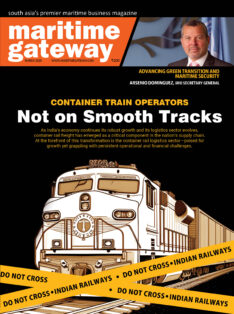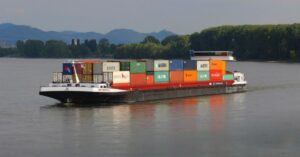“Currently, JM Baxi’s total capacity is 4.5 to 5% of total Indian capacity. To be at 4% of the 10,000MMT capacity, we will atleast need to reach a capacity of 400 million metric tonnes. So, we will need to expand infrastructure at different ports just to retain our share of 4%, by investing in the next 10-15 years.” shares Dhruv Kotak, Managing Director, JM Baxi Group.
Few years ago, in our industry, we have been talking about lot of challenges, whether it is unreponsive bureaucracy or whether it is poor infrastructure or inefficiency in our logistics networks. Being a large player, dominant player in the ports and maritime domain, what is your experience in the recent years, in terms of ease of doing business or in terms of the attitude of the government. What has changed in the recent years and what should change for better?
I think if you have a look at the last decade, we have seen a sea change and that change has been very effective. I think the first change that we started seeing was a push towards making sure that there was a right type of policy framework. If you just look at what has happened over the last decade and then culminating towards the end of previous decade, we saw a lot of policies in the form of Major Port Authorities Act, whether it was mission-led to a transformation in terms of tariffing and a whole bunch of other bills which then became acts. I think we have seen that combined with a number of guidelines, number of policies issued by the Ministry of Ports, Shipping and Waterways, but also other enabling programs in the formation of the department of logistics under the Ministry of Commerce, the National Logistics Policy, the Gatishakti program. I think you are looking at a government framework which has made policy clear, PPP even more clear and refined. The National Investment Pipeline which creates visibility in terms of the opportunities which are there and which needs to be focused on and therefore there is a lot of transparency and a lot of clarity and lot of visibility in terms of policy, opportunity and I would say the overall working framework. So, I think this has been a huge transformation, today when I look at the overall environment, it is very conducive.
Then look at the enabled bureaucratic environment where a lot of the bureaucrats, officers within the government are working and now we have a very clear runway and a very clear playing field in which I think they can carry out a lot of developments. So, I think that’s been a huge plus. There is a lot of private participation happening. I think infrastructure overall has seen a sea change. For instance, look at the railways they have excellently improved in terms of track development and infrastructure creation. Here the government has encouraged private participation with involvement of private players in railway stations and good sheds development, Gatishakti terminals and rolling stock have been privatised. So, combined with investment by the state and the private sector, infrastructure quality has improved. The logistics scenario in India could never have been better than what it is today. But this is not something that has happened overnight. It has taken a decade to get here and I think we really should now take full advantage of this very conducive environment to excel further. For Indian companies and foreign investors this is the opportune time for participating in this growing market and investing in business.
Are there any specific areas which you still want to be changed?
While a lot of improvement has happened, both in terms of policy and infrastructure, be it ports, railways and roadways. We also see it in the form of investment and creation of global level champions in India. The same degree of policy and advocacy is required in the maritime space, i.e., shipping. Here there is still way to go for India to become a global champion in terms of our Indian flagged fleet. We need to create a world class policy framework to enable this. For instance, if you see at the major ports, the government is clearly wanting to exit from operating ports and they want to become more of a landlord. The intent is there but certain services they are still handling like towage, pilotage, energy generation at ports, development of industrial infrastructure, industrial parks or SEZ. Here PPP framework should be created and private players need to come in.
When it comes to investment, maritime finance is a big challenge. You have been on an expansion spree, so, what is the scenario with maritime finance with all these new investments coming in?
JM Baxi operates in the infrastructure space, so most of our expansion is into infrastructure. Infrastructure finance for companies in India is quite good. We have private/public sector and international banks with expertise, we have access to the bond markets. So, there are a lot of options for infrastructure companies. The market is quite well defined and robust.
But, coming to your question on maritime finance, the banking sector needs to understand maritime finance, they don’t understand the nature of the industry. The industry has voiced the need for infrastructure status to the maritime sector and financing services need to be tuned in that manner. But I am sure there are exceptions as well. There are some international banks financing the maritime sector, but lot more needs to be done to create awareness, debts, surety for finance.
We can also look for further regulations like we have in the case of GIFT CITY, where it becomes easier for Indian companies to register themselves, raise funding capital. Another thing is promoting Indian flag, we have to make registration of tonnage under Indian flag to make it as competitive as any other global flag. So that it becomes lucrative for investors and also easy to arrange finance for Indian tonnage.
Indian government has set a huge target of reaching 10,000 MMT by 2047. In your opinion is this target achievable? Where exactly is JM Baxi in this expansion space?
This is a very aggressive target. We are talking of 10 billion tonnes of port handling by 2047. By then I will be close to 65 years old, but I believe that is possible. Considering the growth in demand and the role India is expected to play in the global supply chain. Growth in population and consumption will create this demand, if not 10,000 MMT, it will be close to this figure.
Look at the quantum leap, the increase in port capacity of India is about two and half to three billion tonnes. And we need to reach the goal of 10 billion tonnes. It will need a combination of augmentation of current capacities of those ports that already exist (major and private), upcoming ports and their connectivity, debottlenecking. To start with we need to take the current capacity to 6 billion tonnes through brownfield expansion in the same port ecosystem, which I believe is possible. Then we will need to add further 4 billion tonnes of new greenfield ports. We have seen a lot of development in Uttar Pradesh, Gujarat, Maharashtra, new ports are being planned and some of them will emerge as mega ports as well. Now we need to prepare a national blueprint of where the cargo flows will be and in which locations the capacity addition is needed, it is very important to plan brownfield expansion of existing ports, while new greenfield ports will take time to come. Then connectivity in terms of pipelines, road, rail is critical.
Currently, JM Baxi’s total capacity is 4.5 to 5% of total Indian capacity. To be at 4% of the 10,000MMT capacity, we will atleast need to reach a capacity of 400 million metric tonnes. So, we will need to expand infrastructure at different ports just to retain our share of 4%, by investing in the next 10-15 years.
Apart from being a passionate investor/promoter in the maritime space, you are also Chairman of the FICCI Transport/Logistics Committee. Where do you see the opportunities in the next decade for potential investment on sea side or land side?
Being a port management company I see a lot of potential in ports, terminals and terminal management. As we keep growing the size of the basket keeps increasing. The ports & terminals area will remain very attractive in terms of investment. The second most lucrative sector is inland facilities, be it, warehousing, CFS/ICDs, logistics parks for distribution. Any type is multimodal movement from ports to the hinterland is going to be very significant.
The third significant sector will be the logistics parks, industrial zones and industrial cities around ports and building railway assets around them, ensuring connectivity to global supply chains.
On the sea side there will be more demand for dredging, pilotage services and all the support services on the sea side. There is scope for digitisation, IoT platforms, 4PL logistics.
We have been very positive about the growth of cargo on the east coast, which has not picked up pace to the extent it was expected. Another concern is the growth in coastal movement of cargo which is around 6%. What could be the challenges here and how do we overcome them?
Cargo development on the east coast and growth in coastal shipping, both have been sluggish for the same reasons. In 2020 when COVID hit, the international shipping market was badly impacted. Movement of ships and containers became a challenge particularly to serve the European markets. Coastal shipping and the trade on the east coast of India saw a dip or flattening of growth. Our terminal at Visakhapatnam Port is a prime example, where growth was flat. Ships were blanking calls and container shortage prevailed. But now when you look at Visakhapatnam Port or Chennai port, they are posting a growth rate of 20% to 25% which is greater than the west coast.
As shipping lines add tonnage, there will be more ships looking to find markets. The most lucrative markets in my opinion will be the east coast of India and coastal shipping. You will see more tonnage moving on these routes in the days to come.
Since you have earlier mentioned about technology and automation, on the ports and terminals side what is expected in the days to come?
The maximum thrust is going to be on sensors and sensor-based technology. Connecting to these sensors will be IoT and 5G technology. These will enable real time data analysis and real time decision making tools. As technology develops automation will become lot cheaper and better in the days to come. We will have fully automated terminals but Indian ports can skip the cost curve that the European ports have gone through. In the next one and half year, you can see companies like JM Baxi boasting of home-made terminal automation systems. There will also be a paradigm shift in how we deal with data with processing automation, which was extremely expensive in the past. So, we will be jumping the curve as compared to the western world in terms of automation, speed and cost.
What are your short-term and long-term plans for JM Baxi Group?
We have to do our bit in expanding infrastructure to ensure our country keeps rising on the Global Logistics Performance Index. Supply chains have to be made more agile. The short-term goal will be to ensure we get on stream for all projects we have secured as soon as possible. Making it world class and beyond. The vision is to provide a comprehensive logistics solution at every port and location we operate. Ensure ships turn around quickly and we power our complete operations with green energy. Our logistics networks by rail and road remain efficient with more distribution points with more value generation for each stakeholder across the value chain.











